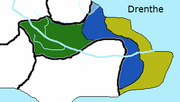| Drenthe Parish | |
|---|---|
| Capital | Drenthe |
| Founded | 22 May 1810 |
| Representative | Eric Peitersson |
| Population | 43,150 (2010) |
| GDP | € 27,250 (per capita) |
| Main Religion | Christianity |
| Languages | Dutch, English |
Drenthe Parish is a Parish located on the southeast coast of Brunant. It stretches along almost a third of the eastern coastline, and continues southward past Cape Parma. Eric Peitersson is the Parish representative. Drenthe is the capital, and Sint-Hendrikstad is the largest city.
History[]
The Drenthe Parish was first settled around 1650 by Flemish immigrants wishing to escape Hapsburg rule, led by explorer Hendrik Faariet, who established a small village known as Sint-Hendrikstad in 1651. However, most of the population is descended from Northern European stock, mainly Swedish, Settler Finnish and Dutch. The capital of the Parish, Drenthe, was founded in 1733 by Dutch and Swedes.
Geography and Climate[]
Drenthe is able to be divided into three destinct geographical regions: balmy and dry Beothusun along the eastern and southern shore; the rolling hills and farmlands of Nieuw Friesland, and the craggy and forested ridges and dells of Kirkenberg.

The hills and farms of Nieuw Friesland.

Martin's Shelf (Maartensplank), the highest point in Drenthe, located in far western Kirkensberg.

Coastal Beothusun
Unlike most other parishes, Drenthe has one-third of the population living in the countryside, and half of those in small, mostly rural localities.

A political map of Drenthe, with the Martiges River shown in light blue.

Beothusun in gold, Nieuw Friesland in blue, and Kirkenberg in green.
In general, the climate tends to be cooler than surrounding regions due to an odd ocean current. However, it is still quite Mediterranean, with the lowest recorded tepmeratures being 21 degrees Fahrenheit. It doesn't get much above 80 degrees in the summer, and typically remains around 65 degrees year-round.
Economy[]

Boat building
The two main industries of Drenthe are agriculture and shipbuilding, in that order. Drenthe produces a significant amount of vegetables from its numerous farms, and is a leading grower of wheat. Much of the cereals are grown in Nieuw Friesland, while orchards and truck farms dominate the scene in Kirkenberg. The salt industry is also significant, as the state has the largest amount of salines (salt ponds) in the country.
Shipbuilders primarily work on the large-scale trawlers that operate out of such maritime centers as Toulon and Nice. They also are well-known for high-quality yachts and sailing vessels, such as the Amelie, built by Arens Drenthe.
As of 2010, unemployment is at 4.8%. While this seems to be implausible, the fact is that most households are able to produce enough food to make a profit and pay taxes. Estimates make it out that if subsistance agriculture were to be excluded from the "self-employed" category, the unemployment rate would be around 7%.
Culture and Society[]
As of 2010, Drenthe Parish has 43,150 residents, including 500 part-time residents who are foreign nationals and 125 citizens of Carrington from Drenthe Parish living abroad.
Most of the population is spread out among small idependent farms as opposed to being in the towns. Drenthe has one of the lowest urbanization rates in the nation at 54%. Religion is popular in Drenthe, with 35% of heads of households answering that they are "somewhat religious" and another 48% saying they are "deeply religious". 17% of the population is either agnostic or athiest, and 81% are Christian. Smaller denominations include Judaism at 1%, Islam at .34%, and "other" at .56%.
The largest Christian denomination is Congregational, followed by Roman Catholic and Lutheran. Smaller groups include Pentecostals, Seventh-Day-Adventists, and Greek Catholic.
